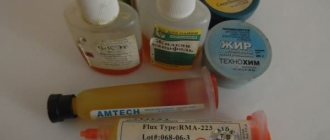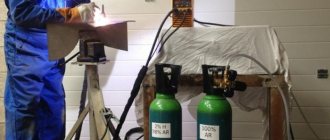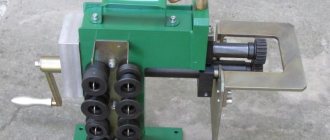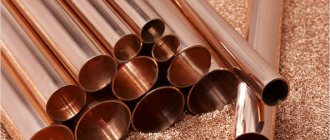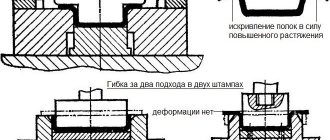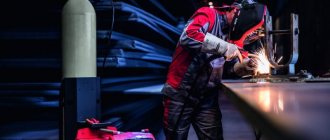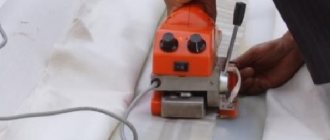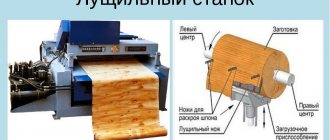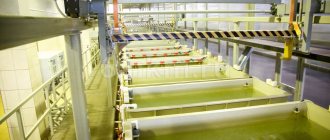Carbon dioxide welding is used not only in industrial conditions, but also in everyday life. The gas forms a protective cloud that prevents air from entering the treated areas. This improves the quality of the welded joint and minimizes the likelihood of defects.
Carbon dioxide welding is used both in industry and in everyday life.
The essence of the process
The method works like this:
- Under the influence of high temperature, the gas partially decomposes into carbon and oxygen. This helps protect the weld pool from impurities present in the air.
- Carbon dioxide and its derivatives react with iron, which increases the strength of the weld.
- When using wire containing silicon or manganese, oxides of these elements are formed. They interact with the metals being welded. An oxidation-resistant compound is formed.
Specifics of technology
Welding in a carbon dioxide atmosphere is a type of electric arc .
The constant discharge of the electric arc releases a large amount of thermal energy, which heats and melts the metal of the workpiece. The current flows through the workpiece, the air gap and the infusible tungsten electrode. The welding material in the form of wire is fed into the working area separately; it does not serve as a conductor. Feeding is carried out at a constant speed by a feed mechanism built into the semi-automatic welding machine.
In order to protect the weld pool from the effects of oxygen and hydrogen in the air, as well as water vapor, a protective atmosphere consisting of carbon dioxide is supplied to the working area. Its cloud displaces air and prevents unwanted chemical reactions
Areas of application
Carbon dioxide is cheaper than helium, argon or other inert gases. However, it is inferior to them in protective qualities. Welding in a carbon dioxide environment is used for routine operations for joining parts made of structural steel.
When working with critical objects, special metals and components experiencing high loads, only helium or argon is used. With the mass creation of standard structures, carbon dioxide technology significantly reduces production costs.
Inverter semi-automatic or classic - transformer.
Like machines for manual arc welding with a covered electrode, semi-automatic machines are of transformer and inverter types. In terms of welding quality, transformers and simple inverters (not synergetic) differ little; they hold the arc the same way. In a simple version, the inverter, like a transformer, produces a constant voltage with a rigid characteristic (more rigid than that of a handbrake, to be more precise), but that’s all, it does not support any digital welding processes. Only synergistic inverter technology is capable of this, which you can read about on our website in the reference materials.
Read also: How to make a ringing call with a multimeter
In the simple version, the advantages of the inverter are somewhat different - light weight, smooth voltage regulation, which can be much more convenient, slightly lower power consumption, possibly, but not necessarily, the ability to work with lower power networks. You need to pay special attention to this if it is important to you. The inverter name is not a guarantee that the device will withstand network voltage drops. As a rule, the standard is 15%, which all devices maintain. More professional devices keep drops from 30% to 50%.
Welding methods
Several methods are used in combination with a protective gas environment. The most common are MIG and TIG modes. It is worth considering the features of each technology.
TIG
When using this method, welding is performed as follows:
- Carbon dioxide is supplied to the treated area.
- Light an arc between the tip of the non-consumable electrode and the metal surface. The seam is filled not with a rod, but with a filler material.
We recommend reading: Choosing a welding inverter
TIG welding.
MIG/MAG
These abbreviations indicate arc welding in an inert or active gas environment. When using carbon dioxide, the apparatus is equipped with a melting additive. Welding is carried out semi-automatically. The use of a non-consumable electrode helps improve work results.
MIG/MAG welding diagram.
Is it possible to reduce consumption?
As noted above, external factors are of great importance during the work process. Therefore, it is desirable to minimize their negative impact. To do this, it is enough to build a closed room, protected from wind and drafts. Do not forget about the safety of the welder by ensuring the room has good ventilation.
Indoors, a filled cylinder will last for a longer period of time.
A special reduction in consumption usually does not lead to the desired result, since in this case the protective functions are reduced and the quality of the welds becomes worse. To reduce consumption, you can use a multicomponent gas mixture, for example, Mixpro 3212, which, in addition, will provide a significant increase in the quality of welding. However, the price of such a mixture will be higher than that of ordinary carbon dioxide. Therefore, the final choice must be made based on technical requirements and budget.
— high-quality gas for welding
If you are really interested in how long carbon dioxide cylinders last, and you do not want to pay for air, then you need to contact only proven and reliable suppliers. A lot of useful information on this issue can be found in the article: carbon dioxide: where to refuel is not an idle question.
not only refills cylinders with technical gases from the best Russian suppliers, but is also their manufacturer. Therefore, there is no doubt about the quality of the filled gas mixture, since all processes are carried out in accordance with established standards, rules and regulations. You will find articles on other technical gases in the corresponding section of the blog.
Preparatory work
Before starting welding, set up the unit as follows:
- Insert the filler wire into the sleeve. Remove the burner nozzle and copper tip, and move the feed roller away. After this, the coil is secured and part of the wire is brought out.
- Set the polarity. When using carbon dioxide and standard wire, choose the opposite option. The positive contact is connected to the burner, the negative contact to the clamp. This way, heat generation will occur on the workpiece being processed. Straight polarity is specified when using a flux additive.
- Connect the semiautomatic device to the electrical network. Press the wire feed button and check the functionality of the mechanism.
- Connect a gas cylinder equipped with a reducer. Carbon dioxide will be supplied through the second channel of the sleeve.
Carbon dioxide consumption
This setting depends on the following factors:
- working conditions (temperature and humidity, presence of wind);
- characteristics of welded metals, consumables;
- welder experience.
Gas consumption is 3-10 liters per minute. When calculating the expected value, the thickness of the parts and the diameter of the filler rod are taken into account. A margin of 10% is added to the resulting number. It accounts for gas consumption during the preparatory stages. 25 kg of liquefied carbon dioxide turns into 500 liters of gas. At average consumption, this volume is enough for 8 hours of operation.
Carbon dioxide welding technology
After setting up the device, perform the following steps:
- Prepare metal elements. They cut the edges, clean the surfaces from grease and rust stains and old paint. For processing, use sandpaper or an iron brush.
- Install the parts in the correct position and fix them.
- Make a test stitch. The device is set to the minimum current. Observe the behavior of the material. When igniting a powerful arc, the edges of the workpieces may become deformed.
- Adjust the operating parameters of the unit taking into account the wire diameter. A welded joint is formed. When connecting thin sheets, the arc is moved forward. When welding thick parts, use the “backward angle” option.
- After welding is completed, gas supply is continued. First of all, stop the additive removal mechanism and disconnect the unit from the network. After this, close the valve of the gas cylinder. This helps the seam cool properly.
- Remove the slag film from the joint surface.
We recommend reading What are MIG, MAG and MMA welding
Welding mode and technique
What you need to pay attention to when carrying out semi-automatic welding in a carbon dioxide environment.
- Welding of metals is carried out using direct current with reverse polarity. This is when the minus is connected to the workpiece, and the plus to the electrode. In this case, with semi-automatic machines for filler wire.
- The current strength is adjusted depending on the thickness of the metals being welded, the speed at which the filler wire is fed into the welding zone, and the voltage of the electric arc.
- Arc voltage is a very important part of the welding process. The size of the weld depends on its value. For example, if the voltage is high, then the width of the seam during the welding process also becomes large.
- Wire extension also plays an important role. If the overhang is small, then the welder has difficulty seeing both the joining process and the welding zone. With a large wire extension, the welding arc is destabilized.
Therefore, the quality of welding depends on the wire ejection from the torch, as well as on the speed of movement of the latter. If the speed is high, welding will occur in intermittent sections. If it is small, then the molten metal will not only fill the gap between the workpieces, but will also flow beyond it, which will lead to subsequent modification of the joint. In addition, at low speeds there is a possibility of burnouts.
As for the technique for semi-automatic welding, it is quite simple and does not require any special manipulations with the torch. First of all, before starting welding work, you need to make sure that carbon dioxide is supplied from the cylinder to the torch. To do this, you just need to open the valve on the cylinder reducer and place your palm under the burner. A slight breeze indicates that the feed system is working properly.
By the way, the pressure of carbon dioxide in the cylinder should be 60-70 kgf/cm², which is controlled by a pressure gauge on the reducer, but the pressure of the gas itself in the burner is shown by the second pressure gauge on the cylinder reducer. Its value should be 2.0 kgf/cm². This indicator is not absolute, because the welding process itself can take place under different conditions. For example, drafts in the workshop, in an open area. Under such conditions, the pressure on the burner must be increased, which will increase the consumption of carbon dioxide.
Everything is ready, you can start welding. To do this, the wire needs to be released a little more from the torch so that it can easily touch the metal being welded to initiate the arc. The end of the wire is installed on the surface of the metal workpiece, after which the welder presses the start button on the torch handle. The arc is ignited, after which the wire is removed to the required size. The valve on the reducer of the carbon dioxide cylinder opens, and carbon dioxide is supplied to the welding zone.
During the carbon dioxide welding process, the torch can be moved in any direction. It is important here that this direction is convenient for the welder. That is, he would be able to monitor and control the welding operation. In this case, the burner should be positioned at an angle of 60-70° relative to the workpiece surface to be welded.
Experts note differences in the direction of welding and the angle of inclination of the wire. For example, if you cook from left to right, then it is better to hold the burner at an angle back. If from right to left, then at an angle forward. In the first case, the welding depth increases sharply, but the width of the weld noticeably decreases. In the second case, on the contrary, the welding depth decreases and the seam width increases. The latter option is best suited for welding thin-walled metal parts.
Attention! The welding process must be completed by completely filling the crater with molten metal. After this, the wire feed must be stopped, but it is better to wait a little while turning off the gas. It is important here that the molten metal in the weld pool cools gradually. Therefore, it is worth maintaining the temperature a little until the metal hardens.
Materials and equipment used
The following types of devices are used to work in a gas environment:
- rectifiers that convert alternating current into direct current (used in combination with graphite and tungsten electrodes);
- inverters that convert electrical energy into a stable arc.
Carbon dioxide
Carbon dioxide is odorless, colorless and non-toxic. Gas containers are coated with black paint. Internal pressure reaches 60 kgf/cm². During the welding process, carbon dioxide breaks down into carbon monoxide and oxygen. Until it cools completely, the seam remains under a protective medium. When supplied, the reducer installed on the cylinder reduces the pressure to 0.5 atmospheres.
Welding wire
The material is selected taking into account the type of unit and the parameters of the parts. Carbon dioxide is not completely inert, so it is used in combination with wire that prevents metal oxidation. The best filler materials are those containing manganese and silicon. Copper-clad wire with anti-corrosion properties is considered a good option.
When choosing the type of additive, the characteristics of the workpieces being welded are taken into account. Carbon dioxide should not be replaced with cored wire. In this case, the quality of the connection deteriorates.
Gas-burner
This piece of equipment must be equipped with durite hoses and a set of cables.
Other
To weld parts you will need the following equipment:
- AC source (inverter or transformer);
- gas supply device with valve;
- cylinder with reducer;
- carbon dioxide dryer connecting the gas container and the burner.
Materials used for carbon dioxide welding. for carbon dioxide welding.
Peculiarities
One of the features of this material is that it is not 100% neutral. This means it must be used with wire, which prevents the entry of oxygen and, consequently, oxidation of the metal.
Wires that contain silicon and manganese are best suited for this type of work. Copper wire would also be a good option, as it has the ability to resist corrosion.
It has a long shelf life and promotes stability in arc burning. Also, the quality of the connection made with copper wire is very good.
Advantages and disadvantages
The positive qualities of the technology under consideration include:
- low cost of work;
- protection of the weld pool from active substances;
- possibility of working suspended, without the use of supports;
- stable arc burning when connecting thin parts;
- efficient consumption of arc thermal energy.
The method also has disadvantages, which can be considered:
- unsuitable for working with non-ferrous metals and alloy steels;
- the difficulty of forming a multi-layer seam;
- danger of poisoning when working in unventilated containers and rooms.
The need for lengthy preparation of equipment and the use of heavy gas cylinders does not allow the use of carbon dioxide welding for small operations that require quick execution.
6.Welding wire
Electrodes used for semi-automatic welding in carbon dioxide have their own characteristics. Welding wire used for submerged arc welding is generally not suitable for working in a carbon dioxide environment.
For welding in carbon dioxide, electrodes with a high content of alloying additives from manganese and silicon are used. The diameter of the wire depends on the type of semi-automatic welding machine and the thickness of the base metal being welded. The surface of the electrodes must be clean, free of rust, scale and organic contaminants. The presence of foreign impurities increases the porosity of the weld and spatters the metal. To clean the electrodes, they are etched in a weak (20%) solution of sulfuric acid and subsequently calcined in an oven.
Safety precautions
The use of shielding gas involves risks of the following dangerous situations:
- poisoning of a welder when working in closed tanks;
- explosion of a cylinder due to an uncontrolled increase in pressure.
We recommend reading: How to pressure cook
Safety regulations have been developed taking these risks into account. When transporting gas containers, you must:
- place all products on a special pallet;
- keep containers upright;
- equip the container with rubber rings to prevent gas leakage.
When refueling and storing, observe the following rules:
- gas sensors must be installed in the premises;
- Exceeding the standard volume is not allowed;
- the temperature of the cylinder should not increase during refilling;
- Do not touch the removable elements of the container without protective gloves.
When working in a confined space you must:
- constantly monitor the level of CO2 in the air;
- ventilate the room or wear an oxygen supply insulating mask;
- work with a partner (the second person should be outside the tank).
Components for carbon dioxide welding
Carbon dioxide storage cylinder
Wire for semi-automatic welding. Used as an electrode. For each case, depending on what metal we will solder, the wire must be selected individually.
Based on the thickness of the metal being welded, the power of the semi-automatic machine and its other features, the diameter of the wire can vary in the range from 0.5 to 3 mm. In practice, copper wire shows the best results, and we recommend using it.
It is necessary to use only clean material, without traces of rust, corrosion, or contamination, which has been stored in proper conditions.
Otherwise, this wire cannot be used unless you want to end up with a poor quality connection. It is recommended to soak the wire in sulfuric acid and then hold it at high temperature for several hours.
Carbon dioxide CO2. Actually, our main highlight of the program and the most important component. Carbon dioxide for semi-automatic welding is harmless to humans and colorless.
CO2 is transported and stored, as a rule, under pressure in special black containers and marked with the same name. Here are some practical and simply useful operating tips:
- for particularly important and complex work, use a container with a 99% carbon dioxide content; in other cases, containers with a 98% content will be sufficient;
- Please note that excess moisture will negatively affect the overall quality of welding. To get rid of it, place the container in a vertical position for one hour, during which time the moisture will settle to the bottom;
- Before starting semi-automatic welding, release a little gas from the container to get rid of nitrogen impurities contained in it that are harmful to welding.

